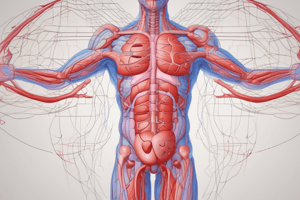Podcast
Questions and Answers
Which of the following is a direct consequence of a decrease in osmotic pressure in blood vessels?
Which of the following is a direct consequence of a decrease in osmotic pressure in blood vessels?
- Increased blood pressure
- Fluid accumulation in tissues (correct)
- Decreased blood volume
- Increased protein synthesis in the liver
What is the primary factor responsible for the decrease in osmotic pressure in blood vessels?
What is the primary factor responsible for the decrease in osmotic pressure in blood vessels?
- Increased blood viscosity
- Reduced blood flow rate
- Loss of water from the bloodstream
- Loss of proteins from the bloodstream (correct)
What is the condition called when fluid accumulates in the abdominal cavity due to decreased osmotic pressure in blood vessels?
What is the condition called when fluid accumulates in the abdominal cavity due to decreased osmotic pressure in blood vessels?
- Hydrocephalus
- Pleural Effusion
- Edema
- Ascites (correct)
How does blood protein loss affect the ability of the blood to regulate bodily fluid volume?
How does blood protein loss affect the ability of the blood to regulate bodily fluid volume?
Which of the following best describes the relationship between blood volume and fluid volume in the body?
Which of the following best describes the relationship between blood volume and fluid volume in the body?
What is the difference between plasma and serum?
What is the difference between plasma and serum?
What is the function of fibrinogen?
What is the function of fibrinogen?
Which of the following statements about blood clotting is TRUE?
Which of the following statements about blood clotting is TRUE?
What is the role of serum in the blood clotting process?
What is the role of serum in the blood clotting process?
The text mentions that serum contains "clotting factors": what does this phrase mean?
The text mentions that serum contains "clotting factors": what does this phrase mean?
What is one function of proteins related to ions in the body?
What is one function of proteins related to ions in the body?
Why are some ions considered harmful in the body?
Why are some ions considered harmful in the body?
How do proteins protect the body from harmful elements?
How do proteins protect the body from harmful elements?
What might happen if protective proteins did not confine the ions effectively?
What might happen if protective proteins did not confine the ions effectively?
Which statement is true about the relationship between proteins and ions?
Which statement is true about the relationship between proteins and ions?
What percentage of total blood volume is made up of plasma?
What percentage of total blood volume is made up of plasma?
Which components account for less than 1% of total blood volume?
Which components account for less than 1% of total blood volume?
When considering the total percentage volume of blood cells, how are White Blood Cells and Platelets typically categorized?
When considering the total percentage volume of blood cells, how are White Blood Cells and Platelets typically categorized?
What constitutes the remaining percentage of blood volume after accounting for plasma?
What constitutes the remaining percentage of blood volume after accounting for plasma?
What is the total blood cell volume if plasma makes up 55% of the total blood volume?
What is the total blood cell volume if plasma makes up 55% of the total blood volume?
Why is iron bound to a transporter protein in the blood?
Why is iron bound to a transporter protein in the blood?
What is the purpose of centrifugation when processing a blood sample?
What is the purpose of centrifugation when processing a blood sample?
What happens to the components of blood when centrifuged?
What happens to the components of blood when centrifuged?
Which of the following is a result of blood centrifugation?
Which of the following is a result of blood centrifugation?
What characteristic of iron makes it necessary to be bound in the blood?
What characteristic of iron makes it necessary to be bound in the blood?
What is the primary purpose of a finger stick?
What is the primary purpose of a finger stick?
What is the most accurate description of the primary difference between a venipuncture and a finger stick?
What is the most accurate description of the primary difference between a venipuncture and a finger stick?
Why is an arteriole stick performed?
Why is an arteriole stick performed?
What is the classification of blood within the body?
What is the classification of blood within the body?
What is the main reason for performing a venipuncture?
What is the main reason for performing a venipuncture?
Flashcards
Osmotic pressure of blood
Osmotic pressure of blood
The force that draws fluid from the surrounding tissues into the blood vessels.
Role of blood proteins in osmotic pressure
Role of blood proteins in osmotic pressure
Proteins in the blood help maintain its osmotic pressure, drawing fluid from tissues into the blood vessels.
Effect of protein loss on osmotic pressure
Effect of protein loss on osmotic pressure
When blood loses proteins, its osmotic pressure decreases, leading to fluid buildup in tissues.
Edema
Edema
Signup and view all the flashcards
Ascites
Ascites
Signup and view all the flashcards
Centrifugation
Centrifugation
Signup and view all the flashcards
Centrifuge
Centrifuge
Signup and view all the flashcards
Blood Sediment
Blood Sediment
Signup and view all the flashcards
Plasma
Plasma
Signup and view all the flashcards
Iron Transporter Protein
Iron Transporter Protein
Signup and view all the flashcards
Protective Proteins
Protective Proteins
Signup and view all the flashcards
Harmful Elements and Ions
Harmful Elements and Ions
Signup and view all the flashcards
Confining Harmful Elements
Confining Harmful Elements
Signup and view all the flashcards
Essential but Localized
Essential but Localized
Signup and view all the flashcards
Body's Protective Mechanism
Body's Protective Mechanism
Signup and view all the flashcards
Blood Cells
Blood Cells
Signup and view all the flashcards
Hematocrit
Hematocrit
Signup and view all the flashcards
Plasma Volume
Plasma Volume
Signup and view all the flashcards
Minor Blood Cells
Minor Blood Cells
Signup and view all the flashcards
What is serum?
What is serum?
Signup and view all the flashcards
What is fibrinogen?
What is fibrinogen?
Signup and view all the flashcards
What is the main function of blood clotting?
What is the main function of blood clotting?
Signup and view all the flashcards
Why is serum used in laboratory tests?
Why is serum used in laboratory tests?
Signup and view all the flashcards
Why is understanding the components of blood significant?
Why is understanding the components of blood significant?
Signup and view all the flashcards
Venipuncture
Venipuncture
Signup and view all the flashcards
Finger Stick
Finger Stick
Signup and view all the flashcards
Blood as a Connective Tissue
Blood as a Connective Tissue
Signup and view all the flashcards
Arterial Stick
Arterial Stick
Signup and view all the flashcards
Heel Stick
Heel Stick
Signup and view all the flashcards
Study Notes
Blood Functions
- Blood transports elements like oxygen (O2), carbon dioxide (CO2), nutrients, waste products, and hormones.
- Blood regulates pH levels, temperature, and blood pressure. Buffers (like CO2 and bicarbonate) are crucial for pH balance, along with lungs, kidneys, and blood.
- Blood vessels dilate (expand) when body temperature is high to release heat, and constrict (shrink) when temperature drops to conserve heat.
Blood Pressure
- Blood volume directly affects blood pressure (BP). Higher volume means higher BP, and vice versa.
- Low blood pressure is harmful because it reduces the driving force to vital organs.
- High blood pressure damages blood vessels (leading to ruptures and thrombosis) and strains the heart.
Osmotic Pressure
- Blood proteins create osmotic pressure, crucial for fluid balance in different compartments.
- Imbalances lead to fluid shifts and volume changes, potentially causing diseases like ascites (abdomen swelling) and edema (swelling in tissues.).
- Protein loss in blood lowers osmotic pressure, reducing fluid reabsorption from tissues.
Blood Composition
- Blood separates into layers during centrifugation:
- Dense red layer (red blood cells).
- Buffy coat layer (white blood cells and platelets).
- Clear yellowish fluid (plasma).
- If coagulation occurs beforehand, the top layer(plasma) is called serum.
- Red blood cells (RBCs) comprise about 45% of whole blood volume/weight.
- Plasma, the liquid component, is around 55% of whole blood.
- Plasma consists mainly of water and dissolved substances, including proteins (like albumin, globulins, and fibrinogen) and electrolytes, O2, CO2, glucose, and waste products.
Blood Protection
- Clotting (coagulation) stops blood loss from injuries and prevents pathogen entry.
- The immune system protects against invading microorganisms.
- Proteins in blood protect against harmful elements and ions, which are needed but should stay confined in particular areas. Iron is an example.
Formed Elements (Details)
- Red Blood Cells (RBCs): Approximate 5 million per microliter of blood. Their bi-concave shape is crucial. RBCs make up 99% of formed elements.
- White Blood Cells (WBCs): Around 5000-10000 per microliter, various types (neutrophils, lymphocytes, monocytes, eosinophils, basophils).
- Platelets (Thrombocytes): 150,000-400,000 per microliter.
- Blood's pH range is slightly alkaline (7.35-7.45)
Blood Extraction Methods
- Venipuncture (needle into a vein)
- Finger/heel prick
- Arteriole stick (measuring gases)
Carboyic Anhydrase
- RBCs contain carbonic anhydrase, this enzyme facilitates CO2 transport in blood.
- The enzyme catalyzes the reaction between CO2 and H2O to form carbonic acid (H2CO3) that dissociates, allowing CO2 transport.
Studying That Suits You
Use AI to generate personalized quizzes and flashcards to suit your learning preferences.
Related Documents
Description
Explore the critical functions of blood in transporting essential elements and regulating body parameters such as pH, temperature, and blood pressure. Understand the role of blood volume in influencing blood pressure and the significance of osmotic pressure in maintaining fluid balance. This quiz will enhance your knowledge about how blood supports overall health.




